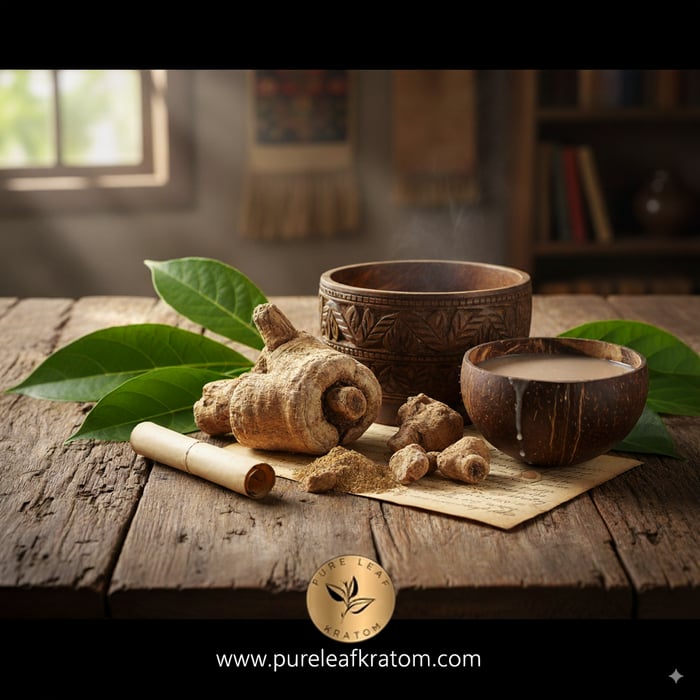
What Is Kava Root? Key Benefits, Usage, & History
Table of Contents
What Is Kava Root? Key Benefits, Usage, & History
For centuries, cultures across the South Pacific have embraced kava root often called kava kava or simply kava as far more than just a plant. It is a deeply rooted symbol of tradition, community, and relaxation. Across generations, friends, families, and entire villages have gathered around shared bowls of kava, using it to mark special occasions, celebrate milestones, or simply enjoy peaceful moments together. In many Pacific Island communities, the preparation and sharing of kava remains an honored ritual, representing harmony, respect, and the spirit of togetherness that binds people to one another.
Kava’s origins trace back thousands of years, and its influence still runs deep in the cultural fabric of islands like Fiji, Tonga, Vanuatu, and Samoa. The simple act of preparing and drinking kava is often treated as a form of ceremony a way to show hospitality, welcome guests, honor leaders, and strengthen communal ties. In these settings, kava isn’t consumed quickly or casually. It’s enjoyed slowly and respectfully, often accompanied by traditional songs, dances, and spoken blessings that emphasize its cultural importance.
In recent years, this once-local treasure has been gaining international attention, steadily making its way into modern wellness circles and social spaces around the world. People are drawn to kava root’s reputation for encouraging calm and connection, and its natural, plant-based origins appeal to those seeking more holistic, authentic alternatives to highly processed products. Today, kava lounges and bars are popping up in major cities from Los Angeles to London, offering a space where people can step away from the noise of everyday life and experience the same sense of grounded relaxation that Pacific cultures have valued for centuries. These modern kava venues often recreate the communal spirit of the traditional experience, giving visitors a taste of both its earthy flavor and its deeper cultural roots.
Yet despite its growing popularity, many people are still curious about what kava root actually is, how it’s used, and why it holds such powerful cultural significance. Is it a tea? A supplement? A ceremonial drink? The truth is, kava is all of these things and more a versatile root with a long history, distinctive properties, and a unique role in both traditional and contemporary lifestyles. Its identity cannot be captured by a single label because it has evolved over centuries to serve many different purposes: a sacred ceremonial beverage, a social connector, and more recently, a botanical enjoyed for its soothing and grounding qualities.
Kava stands apart from many other plants because it carries not only its distinctive taste and characteristics, but also centuries of heritage. Every cup tells a story of island traditions passed from elders to youth, of rituals performed under starlit skies, of communities pausing together to share in silence and connection. Even in its modern forms, whether served from polished wooden bowls in a beachside village or from sleek ceramic cups in a downtown kava bar, it still represents a moment of pause an intentional break from the rush of daily life.
If you’ve ever wondered about this intriguing root, this guide will walk you through everything you need to know about kava from its rich cultural history and ceremonial traditions to its traditional and modern uses, as well as the key benefits that have made it a beloved part of daily life across the globe. By the end, you’ll understand why kava root has stood the test of time and how it continues to bring people together, just as it has done for countless generations.
What Is Kava?
Kava (Piper methysticum) is a tropical evergreen shrub native to the lush islands of the South Pacific, including Fiji, Tonga, Vanuatu, and Samoa. It has thrived in these volcanic soils and humid coastal climates for thousands of years, becoming an essential part of the cultural and social fabric of the region. Its name, kava, comes from the Polynesian word “awa,” meaning “bitter,” a nod to the distinct earthy taste of its root the part of the plant most prized and used.
Traditionally, the root of the kava plant is carefully harvested, peeled, dried, and then ground, crushed, or pounded into a fine material that is mixed with water to produce a cloudy, earthy-tasting beverage. This drink has long been central to ceremonies, rituals, and community gatherings, often served from a communal bowl as friends, family, and leaders sit together in a circle. In many Pacific Island societies, the act of preparing and sharing kava is more than just making a drink — it is a symbol of unity, hospitality, and respect, marking everything from important negotiations and formal events to quiet, peaceful evenings among friends. The preparation itself is considered a ritual, reflecting centuries of tradition, cultural values, and a reverence for the natural world.
As kava has traveled beyond its island roots, it has evolved into a wide variety of modern forms to suit different lifestyles and preferences. Today, you can find kava in several formats, including:
Powdered root – the most traditional form, mixed with water or coconut milk to create ceremonial-style drinks that honor centuries of heritage.
Kava tea bags – a more subtle, beginner-friendly way to enjoy kava as part of a relaxing evening ritual.
Capsules or tablets – convenient, pre-measured servings for those on the go who want a simple and portable option.
Tinctures and liquid extracts – concentrated drops that can be added to beverages for quick and flexible use.
Ready-to-drink kava beverages – pre-bottled or canned drinks designed for modern convenience, often served at kava bars, cafés, or wellness shops.
This range of formats makes kava accessible to a new generation of users while still honoring its rich cultural roots. Whether it is prepared in a traditional ceremonial setting or sipped from a modern ready-to-drink bottle, kava continues to carry the essence of its heritage a connection to nature, community, and mindful relaxation. Each experience, whether ancient or contemporary, preserves the same spirit of presence, respect, and shared enjoyment that has made kava a beloved tradition for centuries.
A Brief History of Kava
Kava boasts a long and rich history, deeply woven into the cultural fabric of Pacific Island societies. For over 3,000 years, it has been cultivated, harvested, and consumed as both a sacred and social beverage. Across generations, kava has served as a bridge between people marking important events, welcoming guests, celebrating milestones, and fostering communal harmony.
Some key highlights of kava’s historical timeline include:
Ceremonial use: Kava was traditionally consumed by chiefs, elders, and honored guests during spiritual, social, and diplomatic rituals. These ceremonies often involved elaborate preparation, specific seating arrangements, and the sharing of the drink in communal bowls, emphasizing respect and mindfulness.
Cultural significance: Beyond its role as a beverage, kava symbolized unity, peaceful dialogue, and mutual respect. Drinking kava together was a gesture that strengthened community bonds, promoted cooperation, and reinforced social hierarchies in a respectful, ceremonial manner.
Spread throughout the Pacific: Originally cultivated in regions like Vanuatu and Fiji, kava gradually spread to Tonga, Samoa, and other Polynesian and Micronesian islands. Each culture adapted its preparation methods, serving traditions, and ceremonial etiquette, enriching the diversity of kava practices across the Pacific.
While its ceremonial role remains strong in many Pacific Island communities today, kava has also captured the curiosity of the wider world. Modern interest has introduced it to wellness routines, social gatherings, and even urban kava lounges far beyond its place of origin. Despite this global expansion, kava continues to carry the essence of its heritage — a living connection to centuries of tradition, community, and mindful enjoyment.
How Kava Is Traditionally Used
For centuries, the preparation of kava has been as meaningful as the drink itself. In its traditional form, dried kava root is carefully ground or pounded into a fine, fibrous powder, often using stone tools or wooden mortars passed down through generations. This powder is then mixed with cool water in a large wooden bowl, and the mixture is kneaded, squeezed, and strained through a fine cloth or mesh to extract the active compounds. The result is a cloudy, earthy-tasting beverage with a distinctive aroma and a smooth, slightly gritty texture.
This ceremonial drink is typically served in a shared bowl or carved coconut shell cups (called bilo) and passed around to participants seated in a circle. The ritual of drinking together fosters a sense of unity, respect, and calm, and it often marks important occasions such as welcoming guests, settling disputes, or celebrating milestones. In many South Pacific cultures, the act of sharing kava is considered just as important as the drink itself a moment to pause, connect, and reflect as a community.
As kava has spread to other parts of the world, modern usage has adapted to fit today’s faster-paced lifestyles. While traditional preparation is still practiced at cultural events and kava bars, many people now prefer more convenient forms that require little to no preparation. These include:
Capsules and tablets for quick, pre-measured servings
Tea bags for an easy, low-effort way to enjoy a gentle brew
Instant kava powders that dissolve quickly in water without straining
Liquid tinctures and extracts that can be added to drinks with just a few drops
Ready-to-drink kava beverages in bottles or cans, perfect for on-the-go use
These modern formats have made kava more accessible to a global audience while still preserving the essence of its tradition. Whether poured from a communal bowl during a village ceremony or enjoyed from a sleek bottle at a city café, kava continues to embody relaxation, connection, and cultural heritage serving as a bridge between ancient rituals and contemporary lifestyles. Each sip carries a story, linking centuries of Pacific Island customs with today’s modern routines and social experiences.
Key Benefits of Kava Kava
Kava’s growing reputation as a wellness botanical stems from the naturally occurring kavalactones in its root, which are responsible for its signature effects. While research on kava is ongoing, it has been traditionally appreciated for its ability to support relaxation, social bonding, and mindful living.
Below is an overview of kava’s most widely appreciated benefits:
| Benefit | Description | Why People Value It |
|---|---|---|
| Promotes Relaxation | Kava has long been known for creating a calm, centered state of mind. It’s often sipped slowly, encouraging people to slow down and unwind after a busy day. | Popular as an evening beverage, weekend ritual, or for winding down after work or social activities. |
| Supports Social Connection | Traditionally served during village ceremonies, kava has always played a role in bringing people together in a respectful, harmonious setting. | Many enjoy it in kava bars or lounges, where it creates a mellow atmosphere for meaningful conversations. |
| Encourages Mindful Moments | The slower pace of drinking kava allows people to be present and reflective, making it ideal for meditative or introspective moments. | Used as part of personal rituals like journaling, quiet reading, or peaceful end-of-day routines. |
| Offers a Natural Alternative to Alcohol | Kava is non-alcoholic yet provides a sense of calm that feels socially similar to having a drink—without the hangover or intoxication. | Appeals to those seeking balance, wellness, or a mindful alternative to traditional nightlife habits. |
Tip: Many people find that the setting plays a huge role in the experience calm music, dim lighting, and relaxed company can enhance kava’s sense of ease and connection.
Modern Ways to Enjoy Kava
While the traditional kava drink remains an important cultural ritual in the South Pacific, today’s market offers a variety of modern formats that make it easier than ever to enjoy this unique botanical. Whether you’re new to kava or a longtime enthusiast, these options provide flexibility and convenience, allowing you to fit kava into your daily routine without needing to master the traditional preparation process.
Instant kava powders – These powders are designed to dissolve quickly in water, offering a fast and hassle-free way to enjoy kava. Perfect for those who want the experience without the time commitment of traditional preparation.
Kava teas – A convenient and soothing option, kava teas are pre-portioned and easy to brew. They make for a relaxing evening beverage or a simple way to wind down after a long day.
Capsules and tablets – Ideal for anyone with a busy lifestyle, kava capsules and tablets are discreet, portable, and easy to dose. They allow you to enjoy kava anywhere, anytime, without the need for mixing or preparation.
Liquid tinctures or shots – Concentrated kava liquids provide a fast-acting experience and are often formulated for precise dosing. They’re great for those who want a quick, on-the-go option that doesn’t compromise potency.
Kava bars – These specialized cafés serve fresh kava drinks in social, community-oriented settings. Kava bars offer a unique way to explore different kava varieties while enjoying the atmosphere of a café designed around this traditional beverage.
Each method brings its own combination of convenience, potency, and experience. Whether you’re looking for a quick drink, a relaxing tea, or a social experience, modern kava products make it simple to enjoy this traditional botanical in ways that suit your lifestyle. With so many options available, there’s never been a better time to explore the diverse ways kava can fit into your day.
A Few Things to Know Before You Try Kava
Trying kava for the first time can be an exciting and unique experience, but keeping a few key points in mind will help ensure that your experience is both enjoyable and meaningful. Whether you’re exploring traditional preparations or modern formats such as teas, capsules, or ready-to-drink beverages, these tips can guide you to get the most out of your first encounter with this historic botanical.
Start small – If you’re new to kava, it’s best to begin with a modest amount. Each person’s body responds differently to the root, so starting with a small serving allows you to understand how it affects you. Gradually increasing the amount over time helps you find the perfect balance for your own comfort and enjoyment. Beginning with smaller doses also gives you the opportunity to savor the flavor and ritual without feeling overwhelmed.
Quality matters – The quality of kava can make a huge difference in taste, texture, and overall experience. Look for reputable brands that source high-quality kava root and conduct rigorous testing for purity and consistency. Premium kava often comes from specific islands or regions and may indicate strain or preparation method. Choosing high-quality kava ensures that you enjoy the full, earthy flavor, aroma, and traditional characteristics, while also supporting ethical sourcing practices and respecting the centuries of care that go into cultivating the plant.
Stay hydrated – Kava, particularly in concentrated forms such as tinctures, shots, or extracts, can have a dehydrating effect. Drinking water alongside your kava helps maintain balance and ensures that your experience remains comfortable. Pairing kava with herbal teas, light snacks, or coconut water can also enhance flavor and enjoyment. Staying hydrated allows your body to fully absorb the nuances of the root and helps you feel refreshed throughout your experience.
Avoid mixing with alcohol or other substances – For the clearest and safest experience, it’s recommended to avoid combining kava with alcohol or certain other substances. Mixing can create unpredictable effects and may place unnecessary strain on your body. Enjoying kava on its own allows you to fully appreciate its earthy flavors, subtle textures, and the cultural traditions behind the drink. Many enthusiasts find that consuming kava in calm, intentional settings whether alone or with friends enhances both flavor and overall experience.
Mind the timing – Kava is naturally relaxing, so choosing the right time and setting can enhance the experience. Many people prefer evenings or quiet moments of reflection, but experimenting with different times can help you discover what works best for your lifestyle. Some enjoy kava during afternoon breaks, social gatherings, or even before creative work sessions to foster a sense of calm and presence. Aligning your kava ritual with a time that feels right for you can help make the experience more enjoyable and meaningful.
Be patient – The effects of kava are subtle and develop gradually. Take your time sipping each serving and allow your body to adjust. Rushing the experience can diminish the flavor, aroma, and sensory enjoyment of the drink. Treat kava as a mindful ritual — a moment to pause, reflect, and connect with the tradition and culture behind the root. Savoring each sip allows you to notice the nuances of taste, texture, and aroma that make kava such a unique experience.
Respect traditional practices – Kava has a rich cultural heritage, and understanding a bit about its ceremonial uses and traditional preparation can deepen your appreciation. Even when enjoying modern formats, acknowledging its history adds layers of meaning to your experience. Learning about the customs, social etiquette, and communal rituals surrounding kava fosters a greater sense of connection to the plant and the cultures that have cherished it for centuries.
Experiment and find your preferred format – Kava comes in many varieties, strains, and serving methods, from traditional powdered root to teas, capsules, tinctures, and ready-to-drink beverages. Sampling different options allows you to discover what suits your taste, schedule, and lifestyle best. Each format offers its own combination of flavor, potency, and convenience, giving you the freedom to create a personalized kava ritual that works for you.
Create a comfortable environment – Whether you’re enjoying kava alone or with friends, setting a relaxed and mindful space can greatly enhance the experience. Consider factors like lighting, seating, music, or even the company you keep. A calm, intentional setting helps you fully engage your senses and connect with the ritual of drinking kava, whether in a quiet home setting or at a modern kava bar.
Listen to your body – Everyone reacts differently to kava. Pay attention to how your body responds and adjust your servings or frequency accordingly. Respecting your own rhythm ensures a safe and enjoyable experience. Over time, this mindfulness can help you refine your personal kava routine and discover the best ways to integrate it into your day.
Enjoy the ritual, not just the drink – Kava is about more than just consumption; it’s a holistic experience that engages taste, smell, and social connection. Taking the time to prepare, share, or sip kava mindfully can transform your experience into a meaningful ritual that connects you with both tradition and community, even if you’re enjoying it in a modern format.
By keeping these points in mind, newcomers can approach kava with confidence, curiosity, and respect. With patience, attention to quality, and an appreciation for its rich cultural roots, kava can become a meaningful addition to daily routines, social moments, or personal moments of reflection bridging ancient traditions with contemporary lifestyles.
FAQs
1.What Is Kava Root?
Kava (Piper methysticum), often called kava kava, is a tropical evergreen shrub native to the South Pacific islands, including Fiji, Tonga, Vanuatu, and Samoa. The part of the plant most valued is its root, which is traditionally harvested, peeled, dried, and ground into a powder to create a cloudy, earthy-tasting beverage. Kava is deeply rooted in Pacific Island culture, symbolizing community, respect, and mindfulness.
2. Where does kava come from?
Kava has been cultivated for over 3,000 years in Pacific Island communities. Its origins are traced to islands such as Vanuatu and Fiji, and it has long been an important part of local culture, social gatherings, and ceremonies.
3. What is kava traditionally used for?
Traditionally, kava is used in ceremonial and social contexts: to welcome guests, celebrate milestones, honor leaders, and strengthen community bonds. Drinking kava is often a mindful ritual symbolizing unity, respect, and harmony.
4. How is kava prepared?
Traditionally, dried kava root is ground or pounded into a powder, mixed with cool water, kneaded, and strained. The beverage is then served in communal bowls or coconut cups, often in a ceremonial circle.
5. What are the modern forms of kava?
Kava is now available in various convenient formats:
Powdered root
Tea bags
Capsules or tablets
Liquid tinctures or extracts
Ready-to-drink beverages
These formats allow kava to fit into modern lifestyles while honoring tradition.
6. What are the main benefits of kava?
Kava is valued for:
Relaxation – Encourages calm and mindful moments.
Social connection – Fosters harmony in group settings.
Mindfulness – Supports reflective or meditative practices.
Non-alcoholic alternative – Offers social ease without intoxication.
7. How should I start using kava?
Start with a small serving to understand how your body responds. Gradually increase your intake as you find what works best. Always choose high-quality kava for the best taste and experience.
8. Can I mix kava with other substances?
It’s recommended to avoid mixing kava with alcohol or other substances. Drinking kava on its own ensures you fully experience its flavor, texture, and cultural significance.
9. When is the best time to drink kava?
Many people prefer evenings or quiet moments of reflection, but you can experiment to find what suits your lifestyle. The key is to enjoy it in a calm, intentional setting.
10. Where can I enjoy kava?
Kava can be enjoyed in traditional Pacific Island ceremonies, modern kava bars, or at home using powders, teas, capsules, or ready-to-drink beverages. Each setting provides a unique way to connect with the tradition and experience relaxation.




